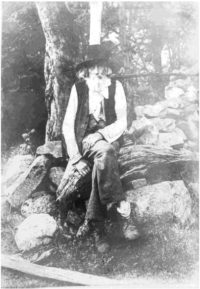Written by Judy Adams, 2009
Nate Nutting lived in Groton during the late 19th century. His home was on a “highway” laid out in 1672 from the Boston Road to the present Old Ayer Road. It was called Hill Side Road in the 1875 Atlas of Middlesex Co., Mass., which shows the site of his house and sawmill. By Nate Nutting’s time, this road had been abandoned due to later road developments and the site was little more than a track through the woods. Today the western end is Indian Hill Road, the eastern end is named for Nate Nutting and the section between is a trail through conservation land.
If you go there today, you will wonder how there was ever enough water to turn a water wheel. Whoever built the sawmill could see that if he dammed up the small stream flowing under the road and over the embankment, he could hold back enough water to turn a mill wheel when he opened the sluiceway, in the Spring at least! Historians tell us that the water table was higher then, so looking back we should imagine more water flowing through the site in those days.
The remains of the earthen dam can still be seen. The stone lined sluiceway still channels the stream from the dam, under the road, and toward the embankment where the wheel once stood. The mill foundation is still there, built of huge stone blocks. And you can see the foundation of the house, between the mill and the road, made of fieldstone with trees and brush now growing in it. On one side of the foundation you can find bricks under the leaf cover, the remains of Nate’s fallen chimney. In the overgrown area below the mill there are remains of some of the mechanisms of the mill operation.
In her book, “Groton Plantation,” Virginia May tells us the story of Nate Nutting. He and his wife were poor simple folk who probably kept pretty much to themselves. When they had to go to the village, they hitched their old milk cow to a wagon. Plodding along, dressed in their shabby country clothes, it’s not hard to image that some thoughtless people laughed and joked about them. A group of boys and young men, who wandered around town, had often harassed Nate and his wife at their isolated home, drinking up their cider and making a nuisance of themselves. Nate had reported this to the local constable but what could be done when they lived so far from town and there was no way to call for help when they needed it. Nate finally decided not to put up with it any longer, to be ready to defend himself and his property with his gun.
On the evening of May 16, 1887, a man made his way through the woods to see Nate Nutting about something. Mrs. May suggests in her book that he had had too much to drink. This seems likely, because an argument started, and the man began to threaten Nate, chasing him up the stairs. Nate was not to be treated badly again; he grabbed his rifle and shot the man. On the stairwell he couldn’t miss; the man was killed and Nate went to jail. But folks sympathized with Nate and his wife. They knew about the young ruffians who terrorized some of the more vulnerable citizens. These folks bailed Nate Nutting out of jail and convinced the Grand Jury that the killing was justifiable homicide. So Nate was let out and went back home to his wife on the Hill Side Road. It’s unlikely anyone came around to bother him again.
